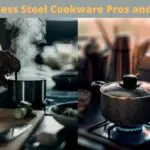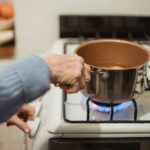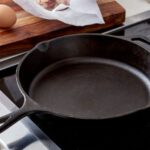Different Types of Non-Stick Coatings

Back in the day, if you wanted to cook something without it sticking to the pan, you had to use a lot of butter or oil. But thanks to advances in non stick coating technology, that’s no longer the case.
Now there are a variety of coatings that can be applied to cookware to create a non stick surface. Here are some of the most popular types of non stick coatings.
In this article we are going to discuss in detail about 3 type of coating, about their history, how they are created, what are their pros and cons and at the end we will try to compare them and will guide you which one is best for you so let’s start.
3 Different Types of Non-Stick Coatings
1. Teflon
Let’s start with Teflon, probably the most well-known non stick coating. Teflon is a synthetic fluoropolymer that was first developed by DuPont in 1938. It was originally intended as a textile treatment, but it was soon discovered that it had excellent non stick properties.
Teflon is created by applying a polymer resin to the cookware surface and then curing it at high temperatures. This creates a hard, non porous surface that is very smooth and slippery.
Teflon is an incredibly effective non stick coating, and it’s also very durable. It can withstand a lot of wear and tear and it’s not easily damaged.
However, there are some drawbacks to Teflon. One is that it can be scratched easily, so you have to be careful not to use anything too abrasive on it.
Another is that it can break down at high temperatures, so you need to be careful not to overheat your food.
Finally, Teflon has been linked to health concerns, so if you’re looking for a non stick coating that’s more natural, you might want to consider one of the other options on this list.
Pros of Teflon Cookware
- Teflon is a very effective non stick coating: The main of reason of being so famous of Teflon is that it works very well as a non stick surface. Foods will not stick to it easily and it’s very easy to clean.
- It’s durable: Teflon is a hard, durable coating that can withstand a lot of wear and tear.
- It’s smooth: Teflon has a smooth surface that is easy to clean.
- Affordable: When you compare Teflon nonstick pans to other types of pans, they are very affordable.
Cons of Teflon Cookware
- It can break down at high temperatures: Teflon starts to break down at around 500 degrees Fahrenheit, so you need to be careful not to overheat your food.
- It’s linked to health concerns: Some studies have linked Teflon exposure to health concerns, so if you’re looking for a non stick coating that’s more natural, you might want to consider one of the other options on this list.
2. Ceramic
Ceramic coatings are another popular type of non stick coating. Ceramic coatings are made from inorganic materials like silicon dioxide or aluminum oxide. They’re applied to cookware in a similar way to Teflon, by applying a resin and then curing it at high temperatures.
Ceramic coatings are very smooth and slippery, so they provide excellent non stick properties.
Ceramic coatings are also generally considered to be safer than Teflon, as they’re not linked to the same health concerns. However, ceramic coating is not as durable as Teflon and it can be scratched easily.
The thing which similar between Teflon and Ceramic cookware is that the core of both is made up of aluminum. The main reason of being aluminum best conductor of heat. That’s the reason why we get to see a lot of Aluminum cookware in the market which is popular for its fast heating property.
Pros of Ceramic Coating Cookware
- Nontoxic: In general, ceramic is a very stable material. It doesn’t leach chemicals, even when heated to high temperatures.
- Nonreactive: This means that it won’t change the flavor or color of your food.
- Keeps Foods from Sticking: The smooth surface of ceramic also helps to prevent sticking.
- Easy to Clean: Because ceramic is nonreactive and nonporous, it doesn’t absorb flavors or colors from foods. This also makes it easy to clean.
Cons of Ceramic Coating Cookware
- Expensive: Ceramic cookware can be more expensive than other types of cookware.
- Not Durable: Ceramic cookware can be easily chipped and the lifespan may be shorter than other types of cookware. However, not all brands are created equal and some are more durable than others.
- Not metal spatula Safe: Another disadvantage of ceramic coating is that it can be scratched by metal utensils.
3. Enameled
Enameled coatings are made from a glass or ceramic material that’s fused to the cookware surface. Enameled cookware has been around for centuries, and it’s still a popular choice today.
Enameled coatings are very smooth and non porous, so they provide excellent non stick properties. They’re also very durable and resistant to scratching. However, enameled coatings can chip easily, so you need to be careful not to drop your cookware.
Pros of Enameled Coating Cookware
- Good Heat Retention: Enameled cookware is a good choice if you’re looking for something that will retain heat well.
- Nonreactive: Enameled cookware is also nonreactive, so it won’t absorb flavors or colors from foods. This makes it easy to clean.
- Work with all kind of Cooktops: It can be used on all types of cooktops, including induction.
Cons of Enameled Coating Cookware
- Expensive: Enameled cookware can be more expensive than other types of cookware.
- Heavy: Enameled cookware is also quite heavy.
Which non stick coating is best for you?
Now that you know a little bit more about the different types of non stick coatings, you might be wondering which one is right for you. The answer to that question depends on a few factors, including your budget, your cooking needs, and your personal preferences.
If you’re looking for the safest option, ceramic and enameled cookware are good choices. If you’re looking for budget friendly option, Teflon is a good choice.
What are the Nonstick Alternatives?
So, far we have discussed about different nonstick coating available in the market. But, what if you don’t want to use any of these? Well, in that case you can opt for some alternatives which are mentioned below –
Hard Anodized Cookware
It is made by electrochemical process which increases the thickness of the aluminum. The good thing about this cookware is that it doesn’t require any nonstick coating as the surface is already nonstick. Moreover, it is also scratch resistant and doesn’t react with acidic food.
Cast Iron Cookware
It is also a good alternative as it is quite affordable and the best thing is that it doesn’t require any nonstick coating and the expected life span is quite long. But, the only problem with this cookware is that it is quite heavy and takes time to heat up.
Additionally, it required to be seasoned before first use and also needs to be maintained properly otherwise it will start rusting.
Fully Clad Cookware
It is made by combining different metals through a process known as roll bonding. The most common combination is stainless steel with aluminum or copper core. The good thing about this cookware is that it heats up quickly and evenly.
If we talk about its coating is then most of the cookware is available with Aluminum Anodized interior which doesn’t require any seasoning. But, the only problem is that it is quite expensive.
Conclusion
Off course you are not going to buy them all together, you will choose one from all these according to your requirements and preferences. So, before buying any cookware first decide what kind of cooking you are going to do in it and then make your decision accordingly.
In our suggesting if you want nonstick cookware that is budget friendly and light weight then go for Teflon cookware.
If you want something that is safe and colorful then go for ceramic cookware.
If you want something which is best for high heat cooking, grilling or broiling then go for cast iron cookware.
And finally, if you have deep pockets and want something that will last for generations then go for fully clad cookware.
Hope this article will help you in making a better decision while buying cookware for your kitchen.




